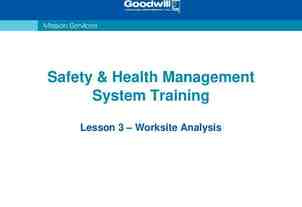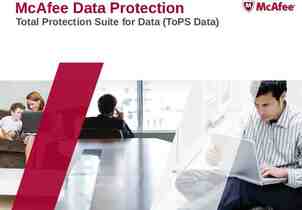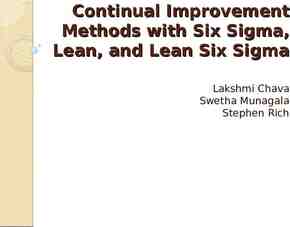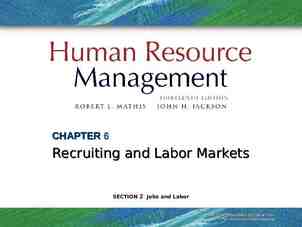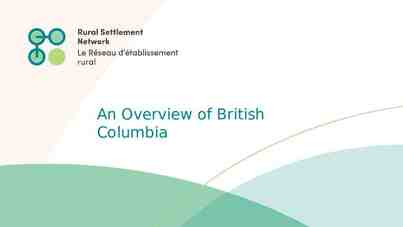What to Teach in Emergency Management Ideas for Those New to the Field
70 Slides319.41 KB

What to Teach in Emergency Management Ideas for Those New to the Field

Welcome! Introduction of attendees Instructor’s background Goals for the workshop A comment about participation

Resources Disaster Research Center Natural Hazards Center FEMA Higher Education Website Links Courses Books Etc.

Resources (cont.) Australian Journal of Emergency Management Disaster Prevention and Management Disasters International Journal of Mass Emergencies and Journal of Emergency Management Journal of Homeland Security and Emergency Management Natural Hazards Review

The Phases of Emergency Management Emergency management focuses on the “four phases” or the “disaster life cycle.” Mitigation Preparedness Response Recovery See Neal’s article 1997 Prevention and protection – new phases?

What is Emergency Management? “Emergency management is the discipline dealing with risk and risk avoidance” (Haddow and Bullock 2006).

What is Emergency Management? (cont.) “Emergency management is the study of how humans and their institutions interact and cope with hazards, vulnerabilities, and resulting events (i.e., emergencies, disasters, catastrophes, and complex humanitarian crises), particularly through activities related to preparedness, response, recovery, and mitigation” (Jensen 2013).

What is Emergency Management? “Emergency management is the discipline and profession of applying science, technology, planning, and management to deal with extreme events that can injure or kill large numbers of people, do extensive damage to property, and disrupt community life” (Hoetmer 1991, xvii)

Principles of Emergency Management Definition: Emergency Management is the managerial function charged with creating the framework within which communities reduce vulnerability to hazards and cope with disasters.

Principles of Emergency Management (cont.) Mission: Emergency management protects communities by coordinating and integrating all activities necessary to build, sustain, and improve the capability to mitigate against, prepare for, respond to and recover from threatened or actual natural disasters, acts of terrorism, or other man-made disasters.

Principles of Emergency Management (cont.) Vision: Emergency management seeks to promote safer, less vulnerable communities with the capacity to cope with hazards and disasters.

Principles of Emergency Management (cont.) 8 Principles Comprehensive Progressive Risk-Driven Integrated Collaborative Coordinated Flexible Professional

Important Concepts Hazard – “natural phenomena that have the potential to cause fatal and costly damage, such as lightning, windstorms and floods” (FEMA 1997, 3). Characteristics (Burton, Kates and White 1993). Value of the concept

Important Concepts (cont.) Risk – “the probability of an event or condition occurring” (Mileti 1999, 106). Also related to the potential for loss.

Important Concepts (cont.) Vulnerability - “the measure of the capacity to weather, resist, or recover from the impacts of a hazard in the long term as well as in the short term” (Mileti 1999, 106).

Important Concepts (cont.) Disaster – “Accidental or uncontrollable events, actual or threatened, that are concentrated in time and space, in which a society, or a relatively selfsufficient subdivision of a society, undergoes severe danger, and incurs such losses to its members and physical appurtenances that the social structure is disrupted and the fulfillment of all or some of the essential functions of the society is prevented” (Fritz 1961, 655).

Important Concepts (cont.) Disaster – “Deadly, destructive and disruptive events that occur when a hazard interacts (or multiple hazards interact) with human vulnerability” (McEntire 2007, 2).

Important Concepts (cont.) Evolution of the term “Disaster” An “evil star” Acts of God Natural hazards Socially disruptive events Socially constructed events See Quarantelli (1998) and Perry and Quarantelli (2005)

Important Concepts (cont.) Scale of events Accidents Crises Emergencies Disasters Calamities and catastrophes

History of Emergency Management Functions have always existed Government was not initially involved Piecemeal and reactive approach Disaster Relief Act and Civil Defense Act National Governors Association and FEMA Witt Revolution 9/11 and Hurricane Katrina See Rubin 2007 for a great review

History of Emergency Management (cont.) Blanchard’s Dirty Baker’s Dozen (Blanchard) Historical Challenges Facing Emergency Management and Homeland Security (McEntire)

Schools of Thought Natural hazards Human behavior American Hazardscapes (Cutter) Human System Responses to Disaster (Drabek) and/or The Human Side of Disaster (Drabek) Radical/critical At Risk (Wisner, Blaikie, Cannon and Davis)

Schools of Thought (cont.) Crisis/Organizational Administrative Normal Accidents (Perrow) Disaster Management in the US and Canada (Waugh and Sylves) Security Terrorism and Homeland Security (Purpura)

Foundational Works Catastrophe and Social Change (Prince) Man and Society in Disaster (Baker and Chapman) Organized Behavior in Disaster (Dynes) When Disaster Strikes (Quarantelli and Dynes) Human System Responses (Drabek) Facing Hazards and Disasters (National Research Council) The Human Side of Disasters (Drabek)

Foundational Works (cont.) The Environment as Hazard (Burton, Kates and White) Interpretations of Calamity (Hewitt) Normal Accidents (Perrow)

Foundational Works (cont.) The Professional Emergency Manager (Drabek) Emergency Management: Principles and Practice for Local Government (Drabek and Hoetmer)

Foundational Works (cont.) Living with Hazards, Dealing with Disasters (Waugh) Introduction to Emergency Management (Haddow and Bullock) Introduction to Emergency Management (Lindell, Prater and Perry) Emergency Management: Principles and Practices for Local Government (second edition) (Waugh and Tierney) Introduction to Emergency Management (Phillips, Neal and Webb)

Foundational Works (cont.) Disaster Management Handbook (Pinkowski) Handbook of Crisis and Emergency Management (Farazmond) Handbook of Disaster Research (Rodriguez, Quarantelli and Dynes) Principles of Emergency Management (Fagel) Managing Emergencies and Crises (Kapucu and Ozerdem)

Foundational Works (cont.) Natural Hazard Mitigation (Godschalk et. al.) Hazard Mitigation and Preparedness (Schwab, Eschelbach and Brower) Disasters by Design (Mileti) Cooperating with Nature (Burby) Paying the Price (Kunreuther)

Foundational Works (cont.) Emergency Planning (Perry and Lindell) Mission Improbable (Clarke) Principles of Emergency Planning and Management (Alexander) Emergency Management: Concepts and Strategies for Effective Programs (Canton)

Foundational Works (cont.) Disaster Response (Auf der Heide) Flirting With Disaster (Schneider) Managing Multi-organizational Responses (Drabek) Managing Disaster (Comfort) Facing the Unexpected (Tierney, Lindell and Perry) Disaster Response and Recovery (McEntire)

Foundational Works (cont.) Community Recovery from a Major Natural Disaster (Rubin) Planning for Post-Disaster Recovery and Reconstruction (Schwab) Holistic Disaster Recovery (PERI) Disaster Recovery (Phillips) Managing for Long-Term Community Recovery in the Aftermath of Disaster (Alesch, Arendt and Holly)

Foundational Works (cont.) Anatomy of Disaster Relief (Kent) Disasters and Development (Cuny) Reflecting on the Weakness of the International Community During the IDNDR (McEntire) Introduction to International Disaster Management (Coppola)

Foundational Works (cont.) Introduction to Homeland Security (Bullock et. al.) Homeland Security (Sauter and Carafano) Homeland Security and Terrorism (Howard et. al.) Introduction to Homeland Security (McEntire) Threats to Homeland Security (Kilroy) Introduction to Homeland Security (Logan and Ramsay) Critical Issues in Homeland Security (Ramsay and Kiltz)

Topical Studies Methods of Disaster Research (Stallings) Cross-National and Comparative Disaster Research (Peacock)

Topical Studies (cont.) Natural Hazards (Keller and Blodgett) Natural Disasters (Alexander) Environmental Hazards (Smith and Petley) Crucibles of Hazard (Mitchell) Natural Hazards Analysis (Pine)

Topical Studies (cont.) Environmental Risks and Hazards (Cutter) The Angry Earth (Oliver Smith and Hoffman) Perceived Stakeholder Role Relationships and Adoption of Seismic Hazard Adjustments (Arlikatti, Lindell and Prater)

Topical Studies (cont.) Disaster Politics and Policy (Sylves) After Disasters (Birkland) Politics of Disaster Relief (May) Disasters and Democracy (Platt)

Topical Studies (cont.) Gender, Risk and Disaster (Fothergill) The Gendered Terrain of Disasters (Enarson and Morrow) Race, Ethnicity and Disasters in the United States (Fothergill, Maestas and Darlington) Social Vulnerability to Disasters (Phillips, Thomas, Fothergill, Blinn-

Topical Studies (cont.) By Design (Geis) Disaster Resilience (Patton and Johnson) Designing Resilience (Comfort, Boin and Demchak) Disaster Insurance Protection (Kunreuther)

Topical Studies (cont.) Conceptualizing and Measuring Disaster Preparedness (Gillespie and Streeter) Are Local Emergency Planning Committees Effective? (Lindell)

Topical Studies (cont.) Response to Disaster (Fischer) Reconsidering Convergence and Converger Legitimacy in Response to the World Trade Center Disaster (Kendra and Wachtendorf)

Topical Studies (cont.) Effective Emergency Management (Phillips and Neal) Creativity in Response to the World Trade Center (Kendra and Wachtendorf)

Topical Studies (cont.) Long Term Recovery (Bates and Peacock) After the Oklahoma City Bombing (Wendell and Baker) Disasters as Agents of Change (Passarini and Mileti)

Topical Studies (cont.) Local Emergency Management Organizations (McEntire) Businesses and Disasters (Webb and Tierney) Private Sector Responses (McEntire, Robinson and Weber)

Topical Studies (cont.) Development in Disaster Prone Places (Lewis) Disaster and Development Research and Practice (Fordham)

Topical Studies (cont.) Disasters, Environment and Development (Varley) Toward the Integration of Sustainable Development and Disasters (Mileti and Darlington) Can Sustainble Development Sustain Us? (Aguirre)

Topical Studies (cont.) Famine, Conflict and Response (Cuny) Mercy Under Fire (Minear and Weiss)

Topical Studies (cont.) Public Health Consequences of Natural Disasters (Noji) The Role of Public Health in Disaster Preparedness, Mitigation, Response and Recovery (Shoaf and Rottman)

Topical Studies (cont.) Problematical Aspects of the Information/Communication Revolution (Quarantelli) The Use of GIS in Disaster Research (Dash) Technology and Emergency Management (Pine)

Topical Studies (cont.) The Environmental Disasters Will be More and Worse, but the Future is not Hopeless (Quarantelli) Worst Cases (Clarke) Preparedness and Response for Catastrophic Disasters (Bissell)

Functional Studies Night and Day (Olsen, Olsen and Gawronski) Planning, Training and Exercises (Daines) Preparing Communities for Disasters (McEntire and Myers) Contingency Plan Exercises (Payne) Community Emergency Response Training (Simpson) Emergency Management Grant

Functional Studies (cont.) Hazard Warning Systems (Sorensen) The Tornado Problem (Golden and Adams) Evacuation Behavior (Fischer) Patterns of Sheltering and Housing in US Disasters (Quarantelli) The Social Organization of Search and Rescue (Aguirre)

Functional Studies (cont.) Triage: History and Horizons (Mayer) Coordination (Drabek) Critical Look at ICS (Buck et. al.) The Role of EOCs in Emergency Management (Scanlon) Principles of EM and EOC (Fagel) The Community Dispatch Center (McEntire and Gardner)

Functional Studies (cont.) Handling the Press (Payne) Local Mass Media Operations (Quarantelli) Coping with the Media (Scanlon) Not on the Record (Scanlon) Transportation Problems in Disasters (Scanlon) The Consequences of Unrequested Donations (Neal)

Functional Studies (cont.) A Need to Help (Lowe and Fothergill) The Damage Assessment Process (Oaks) Damage Assessment After the Paso Robles Earthquake (McEntire and Cope) Debris Management in the 21st Century (Swan) Managing Debris Successfully after Disaster (McEntire)

Functional Studies (cont.) Fatality Management in Mass Casualty Incidents (Hooft) Dealing with Death (Scanlon) The Psychological Impact of Disasters and the Natural of Critical Incident Stress for Emergency Personnel (James)

Important Cases Crisis Management I (Charles and Kim) Crisis Management II (Boin) Handbook of Crisis and Emergency Management (Farazmand) Managing Crises (Howitt and Leonard) Disaster and Human History (Reilly)

Important Cases (cont.) The Loma Prieta Earthquake (Bolin) Hurricane Andrew (Peacock, Morrow and Gladwin) Great Flood of 1993 (Chagnon) Northridge Earthquake (Bolin and Stanford)

Important Cases (cont.) Beyond September 11th (Monday) Learning from Catastrophe (Natural Hazards Center) Disaster: Hurricane Katrina and the Failure of Homeland Security (Cooper and Block)

Pursuit of a Paradigm Comprehensive Emergency Management Resistance From Response to Resilience (Britton and Clarke) Sustainable Development/Sustainable Hazards Mitigation Back to the Future (Armstrong) Resilience Emergency Preparedness Project (NGA) Toward an Integration of Natural Hazards and Sustainability (Mileti et. al.) Comprehensive Vulnerability Management Why Vulnerability Matters (McEntire)

Acceptance of Complexity The Next Catastrophe (Perrow) Disciplines, Disasters and Emergency Management (McEntire)

Recent Work Lower Manhattan Evacuation (Kendra and Lea) Indian Ocean Tsunami (Arlikatti) Recovery (Rozdilsky) Regional Coordination (Andrew and McGehee) Looting (Trainor)

Recent Work (cont.) Social media in disasters (Sykes) Impact of NIMS (Jensen) Mass fatality management (McEntire) Long term recovery (Rubin) Humanitarian Logistics (Christopher and Taham)

Recent Work (cont.) Comparative emergency management (McEntire) Critical Issues in Disaster Science and Management (Trainor and Subio) Disciplinary Focus Group Training and Education Focus Group

Current and Future Concerns Sheltering and disabilities EOC software Daily emergency management operations Management and emergency management Logistics and emergency management

Future Concerns (cont.) Non-profit organizations and emergency management Functional case studies Critical assessment of disaster policies School and workplace violence Terrorism and critical infrastructure Spontaneous planning

Ideas for Program and Classes Advisory board Strengthening curriculum Guest speakers Videos Field trips Student presentations Exercises Assignments and tests Internships

Your Thoughts What else should be discussed and included?

Thank you! David A. McEntire (940) 565-2996 [email protected]

